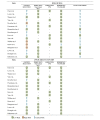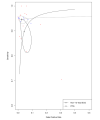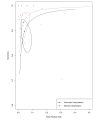Diagnostic Accuracy of Ambulatory Devices in Detecting Atrial Fibrillation: Systematic Review and Meta-analysis
- PMID: 33835039
- PMCID: PMC8065566
- DOI: 10.2196/26167
Diagnostic Accuracy of Ambulatory Devices in Detecting Atrial Fibrillation: Systematic Review and Meta-analysis
Abstract
Background: Atrial fibrillation (AF) is the most common cardiac arrhythmia worldwide. Early diagnosis of AF is crucial for preventing AF-related morbidity, mortality, and economic burden, yet the detection of the disease remains challenging. The 12-lead electrocardiogram (ECG) is the gold standard for the diagnosis of AF. Because of technological advances, ambulatory devices may serve as convenient screening tools for AF.
Objective: The objective of this review was to investigate the diagnostic accuracy of 2 relatively new technologies used in ambulatory devices, non-12-lead ECG and photoplethysmography (PPG), in detecting AF. We performed a meta-analysis to evaluate the diagnostic accuracy of non-12-lead ECG and PPG compared to the reference standard, 12-lead ECG. We also conducted a subgroup analysis to assess the impact of study design and participant recruitment on diagnostic accuracy.
Methods: This systematic review and meta-analysis was conducted in accordance with the Preferred Reporting Items for Systematic Reviews and Meta-Analysis (PRISMA) guidelines. MEDLINE and EMBASE were systematically searched for articles published from January 1, 2015 to January 23, 2021. A bivariate model was used to pool estimates of sensitivity, specificity, positive likelihood ratio (PLR), negative likelihood ratio (NLR), and area under the summary receiver operating curve (SROC) as the main diagnostic measures. Study quality was evaluated using the quality assessment of diagnostic accuracy studies (QUADAS-2) tool.
Results: Our search resulted in 16 studies using either non-12-lead ECG or PPG for detecting AF, comprising 3217 participants and 7623 assessments. The pooled estimates of sensitivity, specificity, PLR, NLR, and diagnostic odds ratio for the detection of AF were 89.7% (95% CI 83.2%-93.9%), 95.7% (95% CI 92.0%-97.7%), 20.64 (95% CI 10.10-42.15), 0.11 (95% CI 0.06-0.19), and 224.75 (95% CI 70.10-720.56), respectively, for the automatic interpretation of non-12-lead ECG measurements and 94.7% (95% CI 93.3%-95.8%), 97.6% (95% CI 94.5%-99.0%), 35.51 (95% CI 18.19-69.31), 0.05 (95% CI 0.04-0.07), and 730.79 (95% CI 309.33-1726.49), respectively, for the automatic interpretation of PPG measurements.
Conclusions: Both non-12-lead ECG and PPG offered high diagnostic accuracies for AF. Detection employing automatic analysis techniques may serve as a useful preliminary screening tool before administering a gold standard test, which generally requires competent physician analyses. Subgroup analysis indicated variations of sensitivity and specificity between studies that recruited low-risk and high-risk populations, warranting future validity tests in the general population.
Trial registration: PROSPERO International Prospective Register of Systematic Reviews CRD42020179937; https://www.crd.york.ac.uk/prospero/display_record.php?RecordID=179937.
Keywords: ambulatory device; ambulatory devices; atrial fibrillation; diagnostic accuracy; electrocardiogram; mobile health; photoplethysmography; technology; ubiquitous health.
©Tien Yun Yang, Li Huang, Shwetambara Malwade, Chien-Yi Hsu, Yang Ching Chen. Originally published in JMIR mHealth and uHealth (http://mhealth.jmir.org), 09.04.2021.
Conflict of interest statement
Conflicts of Interest: None declared.
Figures







References
-
- Odutayo A, Wong CX, Hsiao AJ, Hopewell S, Altman DG, Emdin CA. Atrial fibrillation and risks of cardiovascular disease, renal disease, and death: systematic review and meta-analysis. BMJ. 2016 Sep 06;354:i4482. doi: 10.1136/bmj.i4482. http://www.bmj.com/lookup/pmidlookup?view=long&pmid=27599725 - DOI - PubMed
-
- Kirchhof P, Benussi S, Kotecha D, Ahlsson A, Atar D, Casadei B, Castella M, Diener H, Heidbuchel H, Hendriks J, Hindricks G, Manolis AS, Oldgren J, Popescu BA, Schotten U, Van Putte B, Vardas P, ESC Scientific Document Group 2016 ESC Guidelines for the management of atrial fibrillation developed in collaboration with EACTS. Eur Heart J. 2016 Oct 07;37(38):2893–2962. doi: 10.1093/eurheartj/ehw210. - DOI - PubMed
-
- Jones N, Taylor C, Hobbs F, Bowman L, Casadei B. Screening for atrial fibrillation: a call for evidence. Eur Heart J. 2020 Mar 07;41(10):1075–1085. doi: 10.1093/eurheartj/ehz834. http://europepmc.org/abstract/MED/31811716 - DOI - PMC - PubMed
-
- National Institute for Health and Care Excellence Atrial fibrillation: management (Clinical guideline [CG180]) National Institute for Health and Care Excellence. [2021-01-25]. https://www.nice.org.uk/guidance/cg180. - PubMed
Publication types
MeSH terms
LinkOut - more resources
Full Text Sources
Other Literature Sources
Medical

